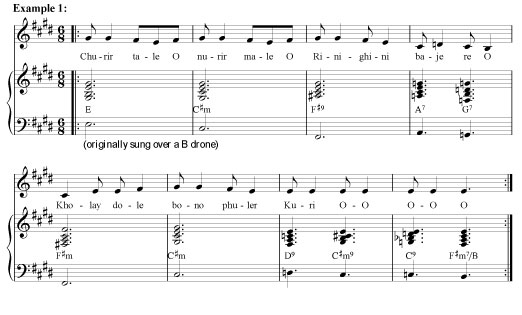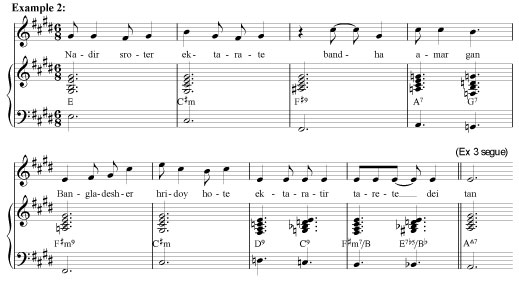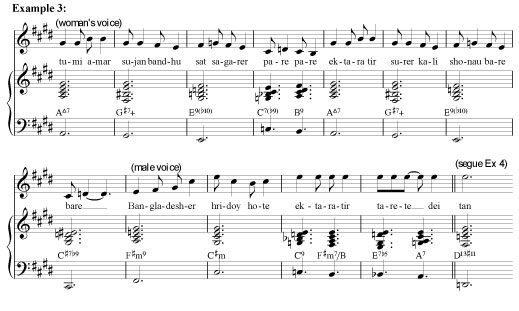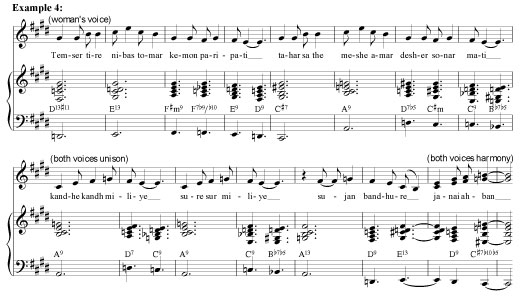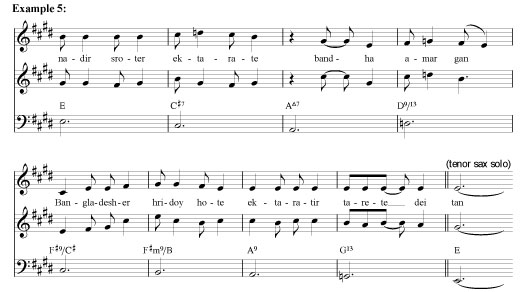A COMPOSER'S BLOG
Tony Haynes, composer/creative director of the Grand Union Orchestra, tells the inside story of his music for the orchestra, its musicians and colourful history.
15: Nasrul and the Dancing Girl
Whenever you hear Lucy Rahman – as you can during Grand Union’s Bengal to Bethnal Green events – it is certain she will sing something by the famous Bengali poet-songwriter Kobi Nasrul (see also Post 14), since she is widely regarded as one of the finest current interpreters of his songs; and it is very likely that one of those songs will be Churir Tale.
The story behind this charming song is that towards the end of his life, Nasrul was captivated one day by a young girl dancing in the market, and as she danced the bangles on her ankles and wrists provided a kind of rhythmic accompaniment; his melody and lyrics capture this image beautifully.
About 15 years ago we were preparing material for a project in Leicester which involved people from the very large (and cultured) South Asian community there, and Lucy suggested Churir Tale. As usual, we wanted to get away from the purely traditional style, and Gerry Hunt (guitar) and Keith Morris (bass) began to improvise some chromatic harmonies against the predominantly pentatonic tune. This is what came out:
The idea isn’t as arbitrary as it seems: the song is effectively sung by an old man poignantly recalling his lost youth, and these harmonies help capture his nostalgia perfectly.
About 10 years later, I was writing a sequence of songs to the lyrics of a later Bengali poet (Masud Ahamed, for 40 years a Birmingham GP!) – originally commissioned for Where the Rivers Meet (Sadler’s Wells 2000) and then featured in the Grand Union Orchestra CD Now Comes the Dragon’s Hour (2001). They tell the the story of a young couple who marry in Bangladesh, but are separated when the young husband comes to London in search of work.
The sequence ends with a love duet also infused with romantic nostalgia – a longing for home, a wife and native land painfully missed, together with their dream of being reunited in the future.
To begin with, therefore, I took the harmonies Gerry and Keith had suggested for the Churir Tale melody (above), but composed a new tune to go with them, which (as in Nasrul’s original) forms the chorus of the song, sung by the man (Akash Sultan):
For the verses, sung by the woman, I took Nasrul’s original melody – which Masud’s new lyrics miraculously fitted! – as well as the chromatic chords, to suggest a voice from the past. (Since Lucy the Nasrul specialist was also the singer in the show and in these recordings, it forms a tribute to her personally as well as to Nasrul.) Each verse is echoed by the last four bars of the chorus sung by Sultan (with small variations in the descending chords in the last 2 bars each time); note how the G#-F#-E pattern of the tune determines the voicings of the harmonies.:
A second verse follows, finishing with the two voices singing together:
Then the two voices sing a version of the chorus as a harmonised duet (Lucy’s part is in fact Nasrul’s original melody):
What follows is a wonderfully lyrical solo by Louise Elliott (tenor saxophone) over the whole chord sequence that has just been sung, completing the transformation of what would traditionally have been perfomed over a drone B and stiff 3/8 tabla rhythm into an expansive, very free 12/8-style blues. (Louise contributes something similar to the Chinese song Picking Betel Palm, Post 12).
After soloing across the whole structure, the tenor sax is pitched against the voices in a short coda over sustained chords:
Lucy Rahman joined the Grand Union Orchestra in 1998 and has been a regular and much valued member ever since, appearing in most of the Company’s touring shows. She is herself descended from a distinguished family of Bengali artists, and her father was a popular singer/songwriter; he was also prominent in the resistance to Pakistan’s political and cultural dominance which eventually led to the war of independence and the birth of Bangladesh as a separate nation in 1973. In On Liberation Street (2005), I wrote a series of songs for her in which a mother describes the progress of the war and the loss of a son who never returned.

